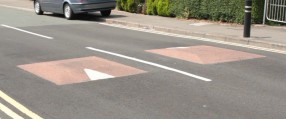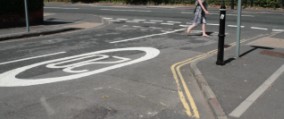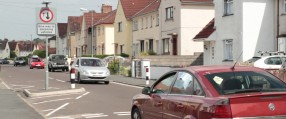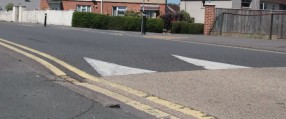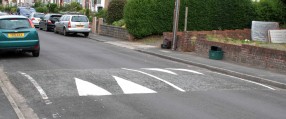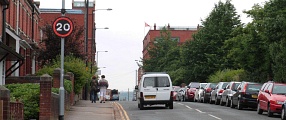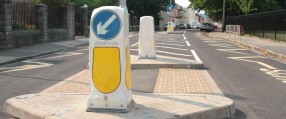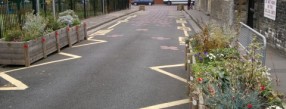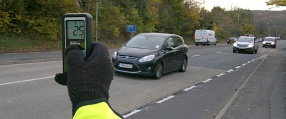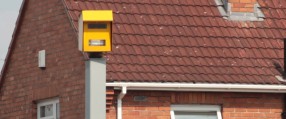Change Lane Markings
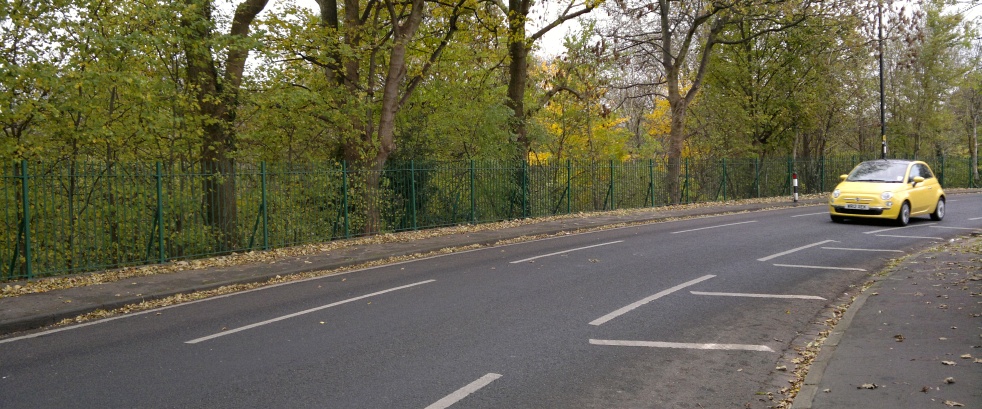
This section explains alternative use of road markings. These measures reduce the feeling of space motor vehicles have, which may help to reduce their speeds.
One technique is reducing the width of the lane for car drivers by adding an additional line inwards from the curb, so both lanes of car traffic are moved towards the centre of the road. The space between the line and the curb is hatched with white lines. This technique is called ‘peripheral hatching’.
Another technique on a two way street is removing the centre line, which is simply removing the white dashed line in the middle of the road.
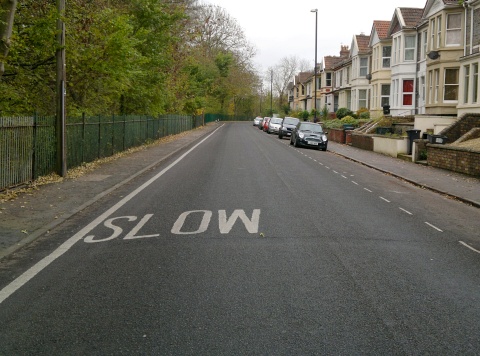
Disadvantages
- Peripheral hatching could be ignored by some motor vehicles drivers, who might still drive in this space
- Removing the centre line may cause some confusion to motor vehicle drivers
Restrictions
- Centre lines should not be removed when traffic speeds are greater than 30mph
- Peripheral hatching can only be used on relatively wide roads (e.g. 12 meters)
- Centre line removal should not happen near one-way streets
There's also some general restrictions to note for all schemes
Advantages
- Does not introduce discomfort to motor vehicle drivers
- Relatively cheap
- Does not reduce accessibility for emergency vehicles or buses
Effectiveness
Peripheral Hatching
Peripheral hatching reduces vehicle speeds by around four percentage points. If a vehicle is travelling at 30 miles an hour, peripheral hatching would normally reduce speeds by at least 1.2 mph.
Removing the Centre Line
This intervention doesn’t have any safety evidence available. Instead, likely outcomes are covered.
If the centre line is removed, this removes motor vehicle driver’s feelings of ‘designated space’ for them to drive in. They may expect other road users to enter their path, or make an unexpected manoeuvre. This is more likely to cause motor vehicle drivers to slow down as a precaution.
Reducing motor vehicle speeds increases safety because:
- The vehicle has travelled less distance before the driver can react to a hazard
- Breaking distance is reduced, so the vehicle can stop more quickly before a hazard
- A slower moving vehicle will exert less energy on occupants as the vehicle rapidly changes speed on impact (crashes)
- A slower moving vehicle will transfer less energy to a pedestrian in the event of a collision.
Considerations
Planters may be more appropriate than peripheral hatching on roads (e.g. residential streets). Planters are part of DIY Streets.
Peripheral hatching: £1,300 (100 meters)
Advanced information
Peripheral Hatching
Speed when passing through peripheral hatching is based on a good quality simulator research study into speed reducing treatments (Jamson et al., 2010). The research specifically compared UK treatments on UK style roads. The research findings are considered to be very conservative, as the study only recruited young (19 to 25 years old) male drivers – younger drivers, and specifically young male drivers are most likely to be speeding, therefore research which is found to be effective on this group is thought to be at least equally effective on other motor vehicle users. A speed reduction of 4% may be greater across an average cross section of motor vehicle drivers.
Removing the Centre Line
In addition to the above, removing the centre could give a greater feeling of ‘shared space’, in which the road feels less like a facility for car drivers, but more for the benefit of all road users, including pedestrians and cyclists. In this case, motor vehicle drivers may be more willing to accommodate and respect other road users, and slow down for road users which are more vulnerable (.e.g pedestrians and cyclists).
References
Jamson, S., Lai, F., Jamson, H. (2010) Driving simulators for robust comparisons: A case study evaluating road safety engineering treatments. Accident Analysis and Prevention 42 pp. 961 - 971
